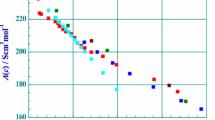Abstract
The electrolytic conductances of NaClO4, NaB(C6H5)4, (n-C4H9)4NClO4 and (n-C4H9)4NPF6 have been measured in methyl acetate at 25°C. A dominating feature of these electrolyte solutions is, as expected, strong ion pairing. In addition it is found that the formation of triple ions makes an important contribution to the overall molar conductivities. The data suggest that there are strong ion-solvent interactions leading to structure-enhanced (after Diamond) ion association and triple ion formation which has an exact analogy in the phenomena of salting-in. The effects of increasing solution permittivity and viscosity are discussed, particularly in regard to comparing two models of treating conductivity data. The first model includes ion pairs and triple ions, and the second model ignores triple ion formation ascribing the anomalous increase in molar conductivities to a decrease in the ion association equilibrium constant caused by increasing solution permittivity.
Similar content being viewed by others
References
E. Plichta, M. Salomon, S. Slane, M. Uchiyama, D. Chua, W. B. Ebner, and H. W. Lin,J. Power Sources 21, 25 (1987).
M. Salomon,Proc. 4 th Intern. Meeting on Li Batteries, J. Power Sources in press.
M. Salomon, M. Uchiyama, M. Xu, and S. Petrucci,J. Phys. Chem. accepted for publication.
J. Barthel, F. Feuerlein, R. Neueder, and R. Wachter,J. Solution Chem. 9, 209 (1980).
M. Salomon and M. Uchiyama,J. Solution Chem. 16, 21 (1987).
T. Lindbäck and P. Beronius,Acta Chem. Scand. A34, 709 (1980).
R. M. Fuoss and K.-L. Hsia,Proc. Natl. Acad. Sci. USA 57, 1550 (1967).
R. Fernandez-Prini and J.-C. Justice,Pure and Appl. Chem. 56, 541 (1984).
M. Salomon and E. Plichta,Electrochim. Acta 28, 1681 (1983).
R. Zana, J. E. Desnoyers, G. Perron, R. L. Kay, and K. Lee,J. Phys. Chem. 86, 3996 (1982).
J. Barthel, R. Wachter, and H.-J. Gores, inModern Aspects of Electrochemistry, Vol. 13, B. E. Conway and J. O'M. Bockris, eds. (Plenum Press, New York, 1979).
M. Salomon and E. Plichta,Electrochim. Acta 29, 731 (1984).
E. Plichta, M. Salomon, S. Slane, M. Uchiyama,J. Solution Chem. 16, 225 (1987).
Y. Marcus,J. Solution Chem. 12, 271 (1983).
B. E. Conway, R. E. Verrall, and J. Desnoyers,Trans. Faraday Soc. 62, 2738 (1966).
G. Atkinson and C. J. Hallada,J. Phys. Chem. 64, 1487 (1960).
R. A. Robinson and R. H. StokesElectrolyte Solutions (Butterworths, London, 1955).
E. Grunwald, G. Baughman, and G. Kohnstam,J. Am. Chem. Soc. 82, 5801 (1960).
J. Barthel, R. Wachter, and H.-J. Gores,J. Chem. Soc. Faraday Disc. 64, 285 (1977).
J. Barthel, H.-J. Gores, G. Schmeer, and R. Wachter,Topics in Current Chemistry, Vol. 111 (Springer-Verlag, Heidelberg, 1982).
R. M. Diamond,J. Phys. Chem. 67, 2513 (1963).
M. Delsignore, H. Faber, and S. Petrucci,J. Phys. Chem. 90, 66 (1986);J. Phys. Chem. (addendum),90, 3294 (1986).
R. M. Fuoss and C. A. Kraus,J. Am. Chem. Soc. 55, 476 (1933).
E. A. S. Cavell and P. C. Knight,Z. Physik. Chem. (NF) 57, 331 (1968).
K. P. Mishchenko and G. M. Poltoratskii,Chimia Moscow, 278 (1968).
I. Svorstol and J. Songstad,Acta Chem. Scand. B39, 639 (1985).
B. Gestblom and J. Songstad,Acta Chem. Scand. B41, 396 (1987).
T. Sigvartsen, B. Gestblom, E. Noreland, and J. Songstad,Acta Chem. Scand. Ser. A (1988).
B. E. Conway,Ionic Hydration in Chemistry and Biophysics (Elsevier, Amsterdam, 1981).
S. Onishi, H. Faber, and S. Petrucci,J. Phys. Chem. 84, 2922 (1980).
H. Faber, D. E. Irish, and S. Petrucci,J. Phys. Chem. 87, 3515 (1983).
H. E. Maaser, and M. Delsignore, M. Newstein, and S. Petrucci,J. Phys. Chem. 85, 5100 (1984).
J.-P. Badiali, H. Cachet, A. Cyrot, and J.-C. Lestrade,J. Chem. Soc. Faraday II 69, 1339 (1973).
H. Faber and S. Petrucci,J. Phys. Chem. 79, 1221 (1975).
P. Debye and J. MacAulay,Z. Phys. Chem. 33, 1015 (1929);Proc. Roy. Soc. (London) A122, 399 (1929).
W. R. Gilkerson and R. E. Stamm,J. Am. Chem. Soc. 82, 5295 (1960).
J.-P. Badiali, H. Cachet, A. Cyrot, and J.-C. Lestrade,J. Chem. Soc. Faraday II 72, 1231 (1976).
G. Beech,Fortran IV in Chemistry (Wiley, London, 1975), pp 41–50.
Author information
Authors and Affiliations
Rights and permissions
About this article
Cite this article
Salomon, M., Slane, S., Plichta, E. et al. Conductance of 1∶1 electrolytes in methyl acetate. J Solution Chem 18, 977–991 (1989). https://doi.org/10.1007/BF00647897
Received:
Revised:
Issue Date:
DOI: https://doi.org/10.1007/BF00647897




